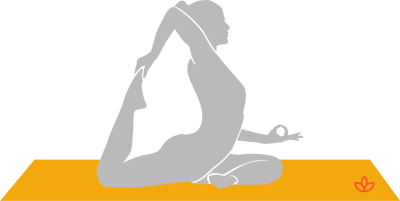Pigeon pose tends to be a love or hate pose for most yogis. Those with open hips that easily externally rotate will melt happily into pigeon and may even wonder what all the fuss is about.
However, yogis who favor internal over external rotation of their hips, those who do a lot of running, cycling or sitting (all of which tend to tighten the muscles of the hips), can find pigeon pose deeply uncomfortable.
Fortunately, the variations of pigeon pose mean that there is a modification for everyone.
Whether you want ways to make this asana more accessible, or find ways to spice it up and go deeper, have a go at these six variations of pigeon pose to get you started. Don’t forget to repeat them all on both sides!
1. Classic Pigeon Pose
Classic pigeon pose, also commonly known by its Sanskrit name, kapotasana, is perfect if you want to work the basic upright pigeon pose, getting a delicious stretch in the hips and releasing the lower back.

How to do it:
- From three-legged downward-facing dog, lift your right leg, bringing your right knee to the back of your right hand.
- Adjust your right foot so that the shin is parallel with the front edge of the mat.
- Alternately, you can keep the heel closer to your groin if your hips feel especially tight.
- Settle into the pose by lowering the left leg so it extends straight back and gently rotate the left hip forward and down.
- Let your palms or fingertips rest on the ground and lengthen your spine.
Read: Bend Without Breaking: 10 Yoga Poses to Increase Flexibility
2. Pigeon on a Perch
Pigeon on a perch is also known as supported pigeon pose or salamba kapotasana. This variation keeps the sit bone of your forward folded leg raised off the ground as you come into classic pigeon pose.
The benefit of this modification is that it raises the hips off the ground, allowing for a gentler stretch in the hamstring and knee.

How to do it: Place a yoga block, blanket or a folded yoga mat under your raised sit bone. This works to bring the ground up to you.
Once your hips are supported, it’s far easier to relax into the pose and allow any tight muscles to release. Additionally, pigeon on a perch is a solid foundation from which you can perform any of the other variations of pigeon.
Read: 5 Yoga Poses to Release Tight Hips
3. Resting Pigeon Pose
Resting pigeon, or extended one-legged pigeon pose, is great if you want a deeper, more yin variation of your pigeon pose.

How to do it:
- From classic pigeon pose, lengthen your spine then fold forward over your front leg.
- Here you can bring your forehead all the way down to the mat, or place blocks or cushions for it to rest on.
- Your hands rest by your head, or reach overhead, stretching your arms out on the mat.
Read: Yin Yoga: 4 Benefits of Surrendering to Your Yoga Mat
4. Revolved Pigeon Pose
Revolved pigeon pose brings a twist into the spine, perfect for releasing the muscles of the back body and letting go of tension.

How to do it:
- From classic pigeon pose with the right leg forward, place your left hand toward the center of your mat in front of your right shin.
- From the hips, rotate your torso to the right, wrapping your right arm around your back to hold the side of your waist, hip or right big toe.
- Inhale to lengthen your spine, exhale to twist a little deeper.
Read: Why We Twist in Yoga: The Benefits of This Simple Action
5. Reclined Pigeon Pose
Reclined pigeon is sometimes affectionately known as "dead pigeon pose." It is also known as supta kapotasana. This variation is draftl for yogis with sensitive knees. It still allows for a hip-opening stretch while keeping the knees protected.

How to do it:
- Lie on your back.
- Place your right ankle across your left thigh close to the knee.
- Externally rotate your right thigh then bring both knees towards your chest.
- Thread your left arm through the gap between your legs and reach your right arm around the outside of your legs to clasp hands either around your left shin or at the back of your left thigh.
- Lower your head and shoulders back to the ground and relax into the posture.
- Draw your knees closer to your chest to increase the stretch.
6. One-Legged King Pigeon Pose A
One-legged king pigeon pose A is the full expression of pigeon pose. It is the most challenging pigeon variation and opens up the whole of the front of your body, hip flexors and shoulders.

How to do it:
- From classic pigeon pose with your right leg in front, bend your left leg, bringing your foot toward your spine.
- Reach one or both arms over your head, then bend your elbows, reaching back to take hold of your foot.
- Lift your drishti (gaze) toward the sky.
Read: 4 Essential Asanas to Increase Flexibility
Patience With Your Pigeon Practice
Love it or hate it, don’t give up on your pigeon pose! There are so many beneficial variations of pigeon that there will always be something new to play with.
Be kind to your body and remember to protect your knees in all variations of pigeon.
Allow your hips to open up in their own time and they will reward you for your patience.
Happy pigeon posing!
During These Times of Stress and Uncertainty Your Doshas May Be Unbalanced.
To help you bring attention to your doshas and to identify what your predominant dosha is, we created the following quiz.
Try not to stress over every question, but simply answer based off your intuition. After all, you know yourself better than anyone else.